Floyd-Warshall AlgorithmThe Floyd-Warshall algorithm is a dynamic programming algorithm used to discover the shortest paths in a weighted graph, which includes negative weight cycles. The algorithm works with the aid of computing the shortest direction between every pair of vertices within the graph, the usage of a matrix of intermediate vertices to keep music of the exceptional-recognized route thus far. But before we get started, let us briefly understand what Dynamic Programming is. Understanding Dynamic ProgrammingDynamic programming is a technique used in computer science and mathematics to remedy complicated troubles with the aid of breaking them down into smaller subproblems and solving each subproblem as simple as soon as. It is a technique of optimization that can be used to locate the pleasant technique to a hassle with the aid of utilizing the solutions to its subproblems. The key idea behind dynamic programming is to keep the solutions to the subproblems in memory, so they can be reused later whilst solving larger problems. This reduces the time and area complexity of the set of rules and lets it resolve tons larger and extra complex issues than a brute force approach might. There are two important styles of dynamic programming:
Memoization involves storing the outcomes of every subproblem in a cache, in order that they may be reused later. Tabulation includes building a desk of answers to subproblems in a bottom-up manner, beginning with the smallest subproblems and working as much as the larger ones. Dynamic programming is utilized in an extensive range of packages, including optimization troubles, computational geometry, gadget studying, and natural language processing. Some well-known examples of problems that may be solved by the usage of dynamic programming consist of the Fibonacci collection, the Knapsack trouble, and the shortest path problem. History of Floyd-Warshall algorithm:The Floyd-Warshall set of rules was advanced independently via Robert Floyd and Stephen Warshall in 1962. Robert Floyd turned into a mathematician and computer scientist at IBM's Thomas J. Watson Research Center, whilst Stephen Warshall became a computer scientist at the University of California, Berkeley. The algorithm was originally developed for use inside the field of operations research, where it turned into used to solve the all-pairs shortest direction problem in directed graphs with tremendous or negative side weights. The problem become of outstanding hobby in operations research, as it has many applications in transportation, conversation, and logistics. Floyd first presented the set of rules in a technical record titled "Algorithm 97: Shortest Path" in 1962. Warshall independently discovered the set of rules quickly afterwards and posted it in his personal technical document, "A Theorem on Boolean Matrices". The algorithm has on account that emerged as a cornerstone of pc technology and is broadly used in lots of regions of studies and enterprise. Its capability to correctly find the shortest paths between all pairs of vertices in a graph, including those with terrible side weights, makes it a treasured tool for solving an extensive range of optimization problems. Working of Floyd-Warshall Algorithm:The set of rules works as follows:
Example:Floyd-Warshall is an algorithm used to locate the shortest course between all pairs of vertices in a weighted graph. It works by means of keeping a matrix of distances between each pair of vertices and updating this matrix iteratively till the shortest paths are discovered. Let's see at an example to illustrate how the Floyd-Warshall algorithm works: Consider the following weighted graph: 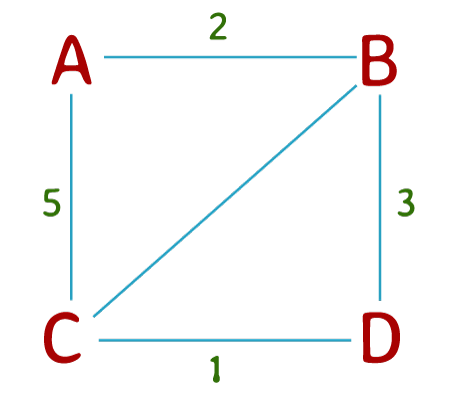
Figure: A Weighted Graph In this graph, the vertices are represented by letters (A, B, C, D), and the numbers on the edges represent the weights of those edges. To follow the Floyd-Warshall algorithm to this graph, we start by way of initializing a matrix of distances among every pair of vertices. If two vertices are immediately related by using a side, their distance is the load of that edge. If there may be no direct edge among vertices, their distance is infinite. 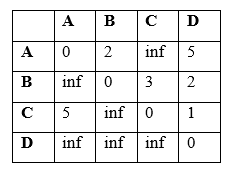
In the first iteration of the set of rules, we keep in mind the possibility of the usage of vertex 1 (A) as an intermediate vertex in paths among all pairs of vertices. If the space from vertex 1 to vertex 2 plus the space from vertex 2 to vertex three is much less than the present-day distance from vertex 1 to vertex three, then we replace the matrix with this new distance. We try this for each possible pair of vertices. 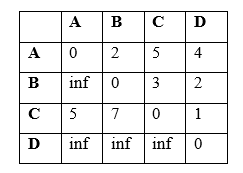
In the second iteration, we recollect the possibility to use of vertex 2 (B) as an intermediate vertex in paths among all pairs of vertices. We replace the matrix in the same manner as earlier before. 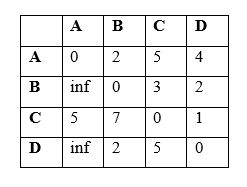
In the third iteration, we consider the possibility of using vertex 3 (C) as an intermediate vertex in paths between all pairs of vertices. 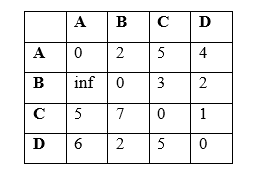
Finally, in the fourth and final iteration, we consider the possibility of using vertex 4 (D) as an intermediate vertex in paths between all pairs of vertices. 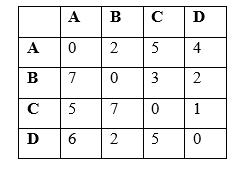
After the fourth iteration, we have got the shortest path between every pair of vertices in the graph. For example, the shortest path from vertex A to vertex D is 4, which is the value in the matrix at row A and column D. After the fourth iteration, we have got the shortest path between every pair of vertices in the graph. For example, the shortest path from vertex A to vertex D is 4, which is the value in the matrix at row A and column D. Implementations of Floyd-Warshall Algorithm in Different Programming Languages:We will now see the implementation of Floyd-Warshall Algorithm in different programming languages like C, C++, Java, and Python. Code Implementation in C:The following is the program code written in C for the implementation of Floyd-Warshall Algorithm. Program Code: Output:
Shortest distances between all pairs of vertices:
0 5 8 9
INF 0 3 4
INF INF 0 1
INF INF INF 0
Code Implementation in C++:The following is the program code written in C++ for the implementation of Floyd-Warshall Algorithm. Program Code: Output:
Shortest distances between all pairs of vertices:
0 5 8 9
INF 0 3 4
INF INF 0 1
INF INF INF 0
Code Implementation in Java:The following is the program code written in Java for the implementation of Floyd-Warshall Algorithm. Program Code: Output: 0 3 3 5 2 0 2 4 3 1 0 5 5 3 2 0 Code Implementation in Python:The following is the program code written in Python for the implementation of Floyd-Warshall Algorithm. Program Code: Output: [0, 3, 6, 5] [2, 0, 4, 4] [inf, 1, 0, inf] [inf, 4, 2, 0] Understanding Time and Space Complexities of Floyd-Warshall Algorithm:Time complexity - This algorithm has an overall time complexity of O(N^3), in which N is the wide variety of vertices within the graph. It is suitable for dense graphs with poor weight cycles, as it can manage them without getting caught in a limitless loop. However, for sparse graphs, different algorithms like Dijkstra's algorithm or Bellman-Ford algorithms can be extra efficient. Let's complete our unfinished discussion of why the Bellman-Ford or Dijkstra's shortest path algorithm is not a suitable option for solving the shortest path problem including all pairs of nodes while we are talking about time complexity. The Bellman-Ford and Dijkstra's shortest path algorithms only calculate the shortest path from one node to all other nodes, and their upper bounds, where nn and mm are the numbers of nodes and edges, respectively, are O(nm) and O(n+mlogn). Additionally, Dijkstra's shortest path algorithm is ineffective for negative weighted edges. If the Bellman-Ford algorithm is expanded to include all nodes, the time complexity changes to n*O(nm) = O(n^2*m). The Floyd Warshall algorithm only considers the number of nodes, hence the maximum number of edges for a directed network can be as high as n*(n-1), meaning that the overall complexity could be as high as O(n^4). As a result, the Floyd-Warshall algorithm is a better option! Space Complexity - The algorithm requires a two-dimensional array, normally called a "distance matrix" to store the shortest path distances among every pair of vertices in the graph. The size of the space matrix is decided by way of the variety of vertices inside the graph, and it has a space complexity of O(V^2), wherein V is the range of vertices within the graph. In addition to the space matrix, the algorithm additionally calls for a two-dimensional array to hold track of the intermediate vertices on the shortest path among any two vertices. This array is normally known as the "path matrix"; and it also has a space complexity of O(V^2). Therefore, the general space complexity of the Floyd-Warshall set of rules is O(V^2), which means that the quantity of memory required through the algorithm grows quadratically with the variety of vertices inside the graph. This can be a problem for big graphs with many vertices, because the algorithm can fast turn out to be memory-extensive and won't be viable to run on machines with restricted memory. Some Advantages and Disadvantages of Floyd-Warshall Algorithm:Let us now discuss some advantages and disadvantages of using Floyd-Warshall Algorithm: Advantages of the Floyd-Warshall algorithm include:
Disadvantages of the Floyd-Warshall set of rules include:
Applications of Floyd Warshall Algorithm:The Floyd-Warshall algorithm is a dynamic programming algorithm used for finding the shortest course among all pairs of vertices in a weighted graph. Here are some of the programs of the Floyd-Warshall algorithm:
These are only some of the numerous applications of the Floyd-Warshall algorithm. It is a powerful algorithm that can be applied in an extensive variety of fields to remedy a whole lot of troubles.
Next TopicCharacteristics of an Algorithm
|
 For Videos Join Our Youtube Channel: Join Now
For Videos Join Our Youtube Channel: Join Now
Feedback
- Send your Feedback to [email protected]
Help Others, Please Share










